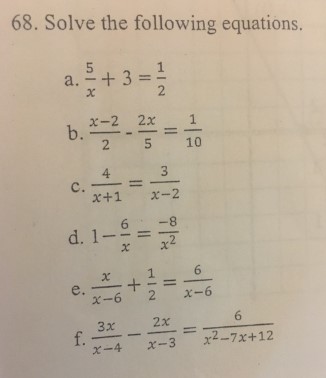QQuestionAnatomy and Physiology
QuestionAnatomy and Physiology
68. Solve the following equations.
\begin{aligned}
& \text { a. } \frac{5}{x}+ 3 =\frac{1}{2} \\
& \text { b. } \frac{x- 2}{2}-\frac{2 x}{5}=\frac{1}{10} \\
& \text { c. } \frac{4}{x+ 1}=\frac{3}{x- 2} \\
& \text { d. } 1 -\frac{6}{x}=\frac{- 8}{x^{2}} \\
& \text { e. } \frac{x}{x- 6}+\frac{1}{2}=\frac{6}{x- 6} \\
& \text { f. } \frac{3 x}{x- 4}-\frac{2 x}{x- 3}=\frac{6}{x^{2}- 7 x+ 12}
\end{aligned}
Attachments

6 months agoReport content
Answer
Full Solution Locked
Sign in to view the complete step-by-step solution and unlock all study resources.
Step 1a.
So, the solution to part (a) is $x = -2$.
To do this, subtract 3 from both sides: Simplify the right side:
Step 2b.
So, the solution to part (b) is $x = 11$.
To solve this equation, first eliminate the fractions by multiplying each term by the least common multiple of the denominators, which is 10: This simplifies to: Expand and simplify: Combine like terms: Add 10 to both sides:
Final Answer
a. $x = - 1$ b. $x = 1$ c. $x = 1$ (Note: There are no solutions that satisfy the original equation.) d. $x = 1$ (Note: $ x = 1$ is an extraneous solution, and there are no solutions that satisfy the original equation.)
Need Help with Homework?
Stuck on a difficult problem? We've got you covered:
- Post your question or upload an image
- Get instant step-by-step solutions
- Learn from our AI and community of students